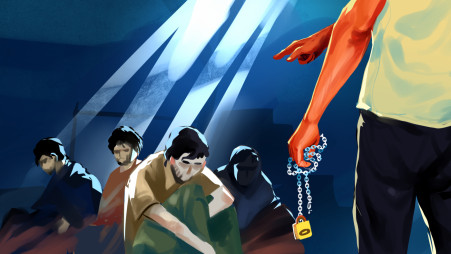Bangladeshis top Mediterranean crossings to Italy amid rising trafficking dangers
In just the first six months of this year, at least 9,735 Bangladeshis entered Italy through this route.

Highlights
- At least 9,735 Bangladeshis entered Italy this way in 2025
- Over 1,000 new trafficking cases were filed in Bangladesh in 2024
- 60% of migrant families were promised jobs; 89% found none
- 63% of migrants were detained en route, 79% of them faced abuse
- New tactics use visit, conference, work, Hajj visas
- Traffickers now use routes via Dubai, Serbia, Saudi Arabia, Russia
Bangladesh now ranks first among countries whose citizens are trying to reach Italy by crossing the Mediterranean Sea, according to the European Border and Coast Guard Agency, Frontex.
In just the first six months of this year, at least 9,735 Bangladeshis entered Italy through this route.
During the journey, many Bangladeshis are held in detention camps in Libya, where they face physical abuse. They are often taken hostage, and their families are forced to pay ransoms. Some even lose their lives.
Despite these dangers, the flow of people travelling to Libya in pursuit of the European dream continues without slowing. Over the past decade, at least 70,000 people have made this journey to Europe.
According to the migration program of the non-governmental organisation BRAC, most people making the journey are between 25 and 40 years old.
People from at least 10 to 12 districts in Bangladesh — including Madaripur, Shariatpur, Sylhet, and Sunamganj — are desperate to reach Europe this way. Various social media platforms, especially Facebook groups, are now widely used to facilitate such journeys.
Even when victims return and file legal cases, the main offenders often remain out of reach.
A report from the Ministry of Home Affairs shows that 1,034 new cases were filed under the Human Trafficking Act in 2024 alone. Including older cases, about 4,500 cases are still pending. Among these, at least 3,000 are in trial, and investigations are not yet complete in over 1,000.
Shariful Hasan, associate director at BRAC, said, "For the past few years, Bangladeshis have been among the top nationalities trying to reach Italy by crossing the Mediterranean Sea. Many lose their lives on this dangerous journey. In Libya, many suffer severe abuse. They are held in camps and tortured. Their families are forced to pay ransom."
"This human trafficking, disguised as overseas jobs or labour migration, is a serious problem. Traffickers now use information technology, but law enforcement agencies are falling behind. On top of that, trafficking cases are not being properly prosecuted. Overall, the situation is alarming," he added.
According to Frontex data, Bangladeshis are the most frequent group trying to enter Europe from Libya via the Central Mediterranean Route. From 2009 to 2024, at least 92,427 Bangladeshis entered Europe this way. Many have died during these attempts. Most recently, in January this year, the decomposed bodies of at least 23 Bangladeshis were found in Libya. They had tried to cross the Mediterranean by boat, but their vessel sank.
A BRAC study found that 60% of the families of those trying to reach Italy this way were convinced by local brokers with promises of good jobs. However, 89% of migrants did not find employment and instead faced danger.
An analysis of travel routes shows that most people reached Libya from Dhaka through Dubai and Egypt. Other common routes include Dhaka to Libya via Istanbul and Dubai, via Qatar, via Dubai and Syria, and in some cases, directly from Dhaka to Libya.
On the way to Libya, 63% of migrants were detained. Among them, 93% were held in camps, and 79% of those detained experienced physical abuse.
New trafficking tactics, routes emerging
Over the past year, BRAC's Migration Programme received help requests from the families of 327 trafficking victims who were abused, detained, jailed, or held in deportation camps in different countries.
With support from the Ministry of Expatriates' Welfare and Overseas Employment, the Ministry of Foreign Affairs, the Wage Earners' Welfare Board, and international organisations, 81 Bangladeshis were safely brought back home from various countries.
While rescuing victims, it was discovered that traffickers are now using visit visas, conference invitations, work permits, and even Hajj visas. New routes include Dubai to Libya to Europe, Dubai to Serbia to Slovenia to Italy, and Saudi Arabia to Russia.
Bangladeshis are also falling victim to brutal cyber scams. This year, 18 Bangladeshis were rescued from Myanmar's notorious "scam centres."
Traffickers are also taking Bangladeshis to Nepal under the pretence of sending them to Europe. Since Nepal offers a visa-on-arrival, traffickers easily move their victims there. In November last year, three Bangladeshis — Tuhinur Islam Anik, Rahim Khandakar, and Shakib Ahmed from Habiganj — were rescued from Nepal after six months.
Other countries now used in trafficking routes include Algeria, Mauritania, Tunisia, Russia, Cambodia, Vietnam, and Serbia.



 Keep updated, follow The Business Standard's Google news channel
Keep updated, follow The Business Standard's Google news channel















